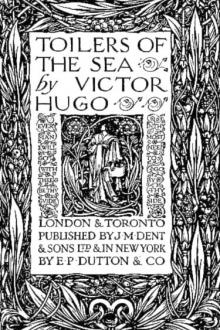Toilers of the Sea by Victor Hugo (trending books to read txt) 📕

- Author: Victor Hugo
- Performer: -
Book online «Toilers of the Sea by Victor Hugo (trending books to read txt) 📕». Author Victor Hugo
But of uncle and of guardian let the troubadour beware."
Unpublished Comedy 72 V. A Deserved Success has always its Detractors 74 VI. The Sloop Cashmere saves a Shipwrecked Crew 75 VII. How an Idler had the Good Fortune to be seen by a Fisherman 77
Book V.—The Revolver I. Conversations at the Jean Auberge 80 II. Clubin observes Someone 86 III. Clubin carries away Something and brings back Nothing 88 IV. Pleinmont 91 V. The Birds'-nesters 96 VI. The Jacressade 108 VII. Nocturnal Buyers and Mysterious Sellers 114 VIII. A "Cannon" off the Red Ball and the Black 117 IX. Useful Information for Persons who expect or fear the Arrival of Letters from beyond Sea 125
Book VI.—The Drunken Steersman and the Sober Captain I. The Douvres 130 II. An Unexpected Flask of Brandy 132 III. Conversations interrupted 135 IV. Captain Clubin displays all his great Qualities 142 V. Clubin reaches the Crowning-point of Glory 147 VI. The Interior of an Abyss suddenly revealed 151 VII. An Unexpected Dénouement 158
Book VII.—The Danger of Opening a Book at Random I. The Pearl at the Foot of a Precipice 162 II. Much Astonishment on the Western Coast 169 III. A Quotation from the Bible 173 PART II MALICIOUS GILLIATT Book I.—The Rock I. The Place which is difficult to reach, and difficult to leave 181 II. A Catalogue of Disasters 186 III. Sound; but not Safe 188 IV. A Preliminary Survey 190 V. A Word upon the Secret Co-operations of the Elements 192 VI. A Stable for the Horse 196 VII. A Chamber for the Voyager 198 VIII. Importunæque Volucres 205 IX. The Rock, and how Gilliatt used it 207 X. The Forge 210 XI. Discovery 214 XII. The Interior of an Edifice under the Sea 217 XIII. What was seen there; and what perceived dimly 219
Book II.—The Labour I. The Resources of one who has nothing 225 II. Wherein Shakespeare and Æschylus meet 227 III. Gilliatt's Masterpiece comes to the Rescue of that of Lethierry 229 IV. Sub Re 232 V. Sub Umbra 237 VI. Gilliatt places the Sloop in readiness 242 VII. Sudden Danger 244 VIII. Movement rather than Progress 247 IX. A Slip between Cup and Lip 250 X. Sea-warnings 252 XI. A Word to the Wise is enough 255
Book III.—The Struggle I. Extremes meet 258 II. The Ocean Winds 259 III. The Noises explained 262 IV. Turba Turma 265 V. Gilliatt's Alternatives 267 VI. The Combat 268
Book IV.—Pitfalls in the Way I. He who is Hungry is not Alone 280 II. The Monster 296 III. Another Kind of Sea-combat 297 IV. Nothing is hidden; Nothing lost 299 V. The Fatal Difference between Six Inches and Two Feet 302 VI. De Profundis ad Altum 306 VII. The Appeal is heard 311 PART III DÉRUCHETTE Book I.—Night and the Moon I. The Harbour Bell 315 II. The Harbour Bell again 327
Book II.—Gratitude and Despotism I. Joy surrounded by Tortures 335 II. The Leathern Trunk 343
Book III.—The Departure of the "Cashmere" I. The Havelet near the Church 346 II. Despair confronts Despair 348 III. The Forethought of Self-sacrifice 355 IV. For your Wife: when you Marry 359 V. The Great Tomb 362 TOILERS OF THE SEA PART I.—SIEUR CLUBIN BOOK I THE HISTORY OF A BAD REPUTATION I A WORD WRITTEN ON A WHITE PAGE
Christmas Day in the year 182- was somewhat remarkable in the island of Guernsey. Snow fell on that day. In the Channel Islands a frosty winter is uncommon, and a fall of snow is an event.
On that Christmas morning, the road which skirts the seashore from St. Peter's Port to the Vale was clothed in white. From midnight till the break of day the snow had been falling. Towards nine o'clock, a little after the rising of the wintry sun, as it was too early yet for the Church of England folks to go to St. Sampson's, or for the Wesleyans to repair to Eldad Chapel, the road was almost deserted. Throughout that portion of the highway which separates the first from the second tower, only three foot-passengers could be seen. These were a child, a man, and a woman. Walking at a distance from each other, these wayfarers had no visible connection. The child, a boy of about eight years old, had stopped, and was looking curiously at the wintry scene. The man walked behind the woman, at a distance of about a hundred paces. Like her he was coming from the direction of the church of St. Sampson. The appearance of the man, who was still young, was something between that of a workman and a sailor. He wore his working-day clothes—a kind of Guernsey shirt of coarse brown stuff, and trousers partly concealed by tarpaulin leggings—a costume which seemed to indicate that, notwithstanding the holy day, he was going to no place of worship. His heavy shoes of rough leather, with their soles covered with large nails, left upon the snow, as he walked, a print more like that of a prison lock than the foot of a man. The woman, on the contrary, was evidently dressed for church. She wore a large mantle of black silk, wadded, under which she had coquettishly adjusted a dress of Irish poplin, trimmed alternately with white and pink; but for her red stockings, she might have been taken for a Parisian. She walked on with a light and free step, so little suggestive of the burden of life that it might easily be seen that she was young. Her movements possessed that subtle grace which indicates the most delicate of all transitions—that soft intermingling, as it were, of two twilights—the passage from the condition of a child to that of womanhood. The man seemed to take no heed of her.
Suddenly, near a group of oaks at the corner of a field, and at the spot called the Basses Maisons, she turned, and the movement seemed to attract the attention of the man. She stopped, seemed to reflect a moment, then stooped, and the man fancied that he could discern that she was tracing with her finger some letters in the snow. Then she rose again, went on her way at a quicker pace, turned once more, this time smiling, and disappeared to the left of the roadway, by the footpath under the hedges which leads to the Ivy Castle. When she had turned for the second time, the man had recognised her as Déruchette, a charming girl of that neighbourhood.
The man felt no need of quickening his pace; and some minutes later he found himself near the group of oaks. Already he had ceased to think of the vanished Déruchette; and if, at that moment, a porpoise had appeared above the water, or a robin had caught his eye in the hedges, it is probable that he would have passed on his way. But it happened that his eyes were fixed upon the ground; his gaze fell mechanically upon the spot where the girl had stopped. Two little footprints were there plainly visible; and beside them he read this word, evidently written by her in the snow—
"GILLIATT."
It was his own name.
He lingered for awhile motionless, looking at the letters, the little footprints, and the snow; and then walked on, evidently in a thoughtful mood.
II THE BÛ DE LA RUEGilliatt lived in the parish of St. Sampson. He was not liked by his neighbours; and there were reasons for that fact.
To begin with, he lived in a queer kind of "haunted" dwelling. In the islands of Jersey and Guernsey, sometimes in the country, but often in streets with many inhabitants, you will come upon a house the entrance to which is completely barricaded. Holly bushes obstruct the doorway, hideous boards, with nails, conceal the windows below; while the casements of the upper stories are neither closed nor open: for all the window-frames are barred, but the glass is broken. If there is a little yard, grass grows between its stones; and the parapet of its wall is crumbling away. If there is a garden, it is choked with nettles, brambles, and hemlock, and strange insects abound in it. The chimneys are cracked, the roof is falling in; so much as can be seen from without of the rooms presents a dismantled appearance. The woodwork is rotten; the stone mildewed. The paper of the walls has dropped away and hangs loose, until it presents a history of the bygone fashions of paper-hangings—the scrawling patterns of the time of the Empire, the crescent-shaped draperies of the Directory, the balustrades and pillars of the days of Louis XVI. The thick draperies of cobwebs, filled with flies, indicate the quiet reign long enjoyed by innumerable spiders. Sometimes a broken jug may be noticed on a shelf. Such houses are considered to be haunted. Satan is popularly believed to visit them by night. Houses are like the human beings who inhabit them. They become to their former selves what the corpse is to the living body. A superstitious belief among the people is sufficient to reduce them to this state of death. Then their aspect is terrible. These ghostly houses are common in the Channel Islands.
The rural and maritime populations are easily moved with notions of the active agency of the powers of evil. Among the Channel Isles, and on the neighbouring coast of France, the ideas of the people on this subject are deeply rooted. In their view, Beelzebub has his ministers in all parts of the earth. It is certain that Belphegor is the ambassador from the infernal regions in France, Hutgin in Italy, Belial in Turkey, Thamuz in Spain, Martinet in Switzerland, and Mammon in England. Satan is an Emperor just like any other: a sort of Satan Cæsar. His establishment is well organised. Dagon is grand almoner, Succor Benoth chief of the Eunuchs; Asmodeus, banker at the gaming-table; Kobal, manager of the theatre, and Verdelet, grand-master of the ceremonies. Nybbas is the court-fool; Wierus, a savant, a good strygologue, and a man of much learning in demonology, calls Nybbas the great parodist.
The Norman fishermen, who frequent the Channel, have many precautions to take at sea, by reason of the illusions with which Satan environs them. It has long been an article of popular faith, that Saint Maclou inhabited





Comments (0)